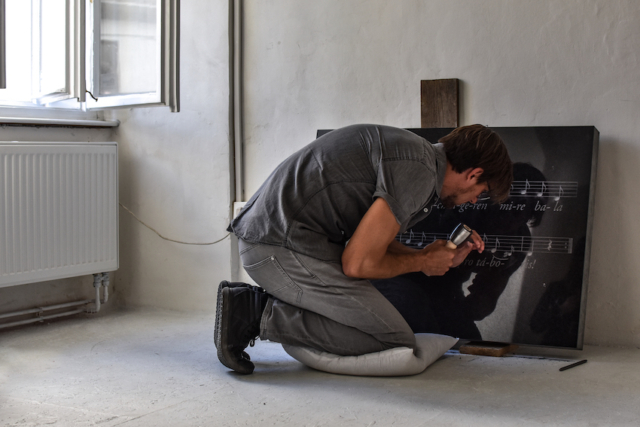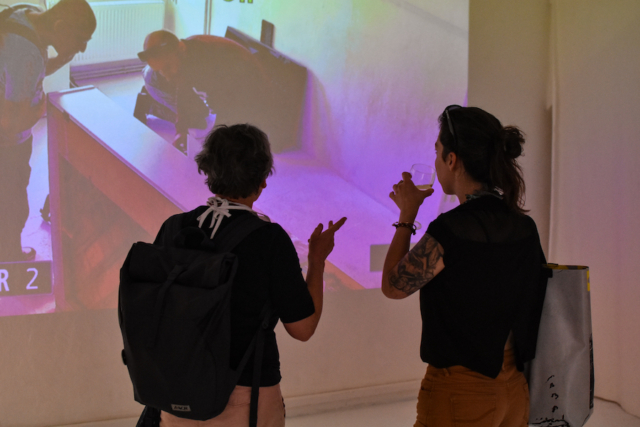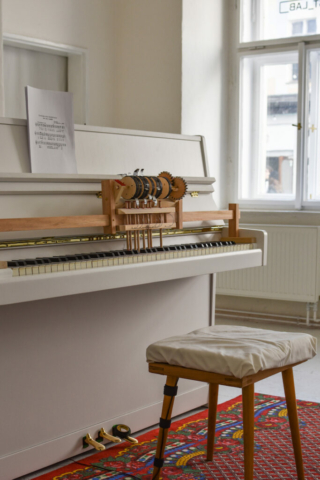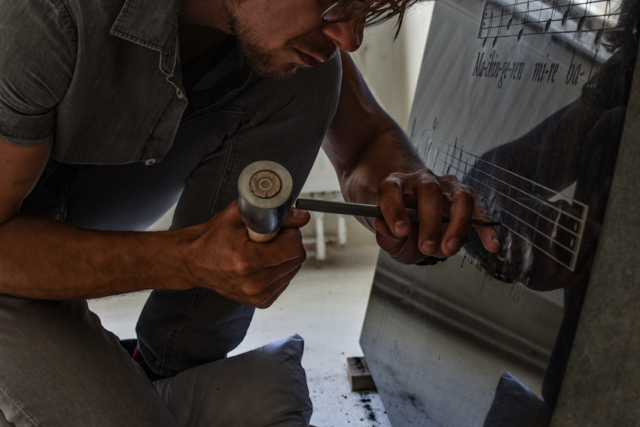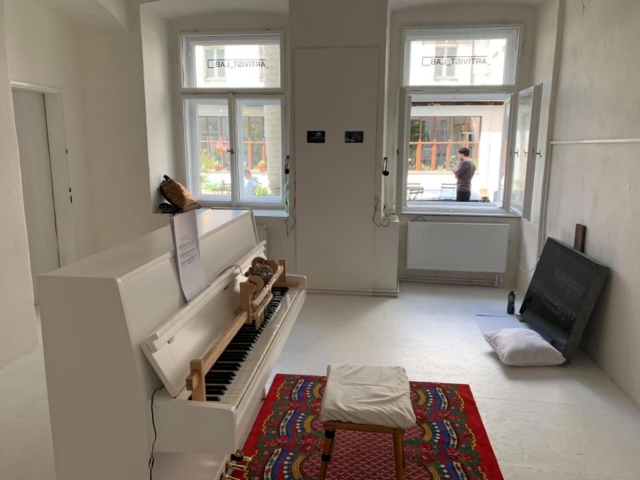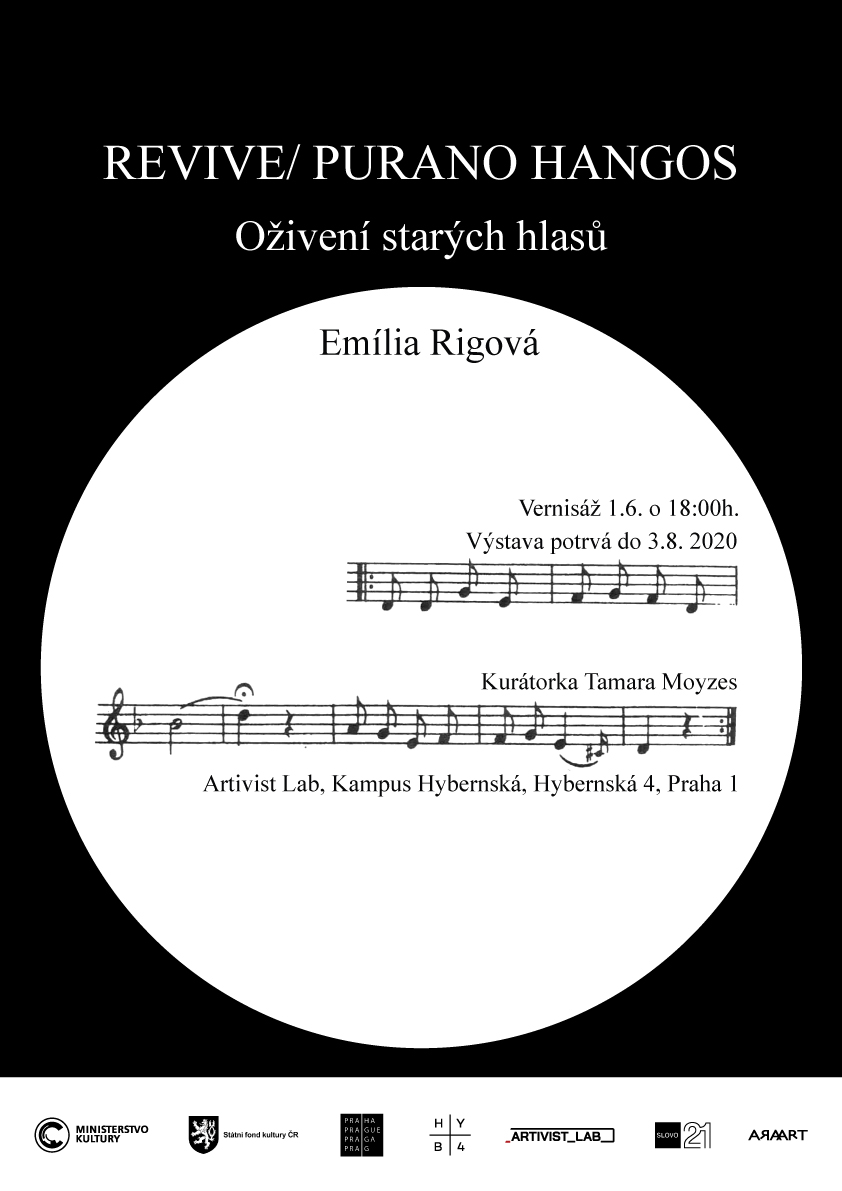Oživení starých hlasů
(for english please scroll down)
Emília Rigová
1. 6. – 3. 8. 2020
Vernisáž proběhne 1.6. o 18: 00h.
Výstavu umělkyně Emílie Rigové jsme v galerii Artvist Lab plánovali již od minulého roku. Původně avizovaný kurátorský výběr videí a fotografií z obsáhlého projektu s názvem Untitled/Deadlock (zač.2014), ve kterém se Rigová věnuje tématu romského holokaustu, jsme hned v počátcích karanténní situace zrušili. Nová autorská výstava „Revive/Purano Hangos“ (Oživení starých hlasů) představuje projekt, na kterém Rigová začala pracovat už v době svého rezidenčního pobytu v NY (2018). Jde o procesuální projekt, kterého „první část“ uvádíme premiérově v prostorách galerie Artivist Lab. Tvorbu Rigové v posledním období charakterizuje autorský/autentický přístup k tématu identity. Zároveň se věnuje i zviditelňování romské kultury či hledání jejích aspektů v majoritní kultuře.
V projektu Revive/Purano Hangos se hlavním zdrojem inspirace stávají staré notové záznamy už zaniknutých romských skladeb. Skladby pocházejí z Klenovce, ze sbírky Bohuslava Valšťana, jež byly v roce 1994 uveřejněny v časopisu „Romano Džaniben“. Roku 1957 nazpíval tyto písně MUDr. Ján Cibuľa, který se po emigraci do Švýcarska stal prvním předsedou Mezinárodního svazu Romů – Romani Union.
Převážná většina romských hudebníků v minulosti hrála podle sluchu, což vedlo k tomu, že notové zápisy nemohly být nikdy přesné. Najít v nich správný rytmus může jen opravdový odborník. Umělkyně tímto procesem záměrně zviditelňuje složitost či určitou nefunkčnost hraní podle notových záznamů.
V uměleckém projektu “REVIVE/ PURANO HANGOS” melodii vracejí život pomocí not právě neromové. Jde o symbolické gesto, které autorka podprahově podsouvá v čtení celého projektu: Gádžové oživují romské písně… Pro Rigovou se notové záznamy starých romských písní stávají zdrojem informace, kterou jí zprostředkovávají neromové. Jelikož sama autorka nepoznala dané písně a nevěděla jak mají znít, vznikl prostor pro individuální zpracování melodie u různých oslovených hudebníků. Většinová společnost tak oživuje staré romské hlasy. V samotném aktu jde symbolicky o určitou historickou spravedlnost. Zároveň romštímuzikanti mají, “Halgáto”, jak se stereotypně říká, “v krvi”, a proto správný rytmus a tóny najdou v notách okamžitě. Umělkyně si pohrává dvojsmyslně s touto realitou. Snaží se o zachování videonahrávek, na kterých hudebníci zpívají podle notových záznamů zaniklé romské skladby a oživují je.
Archivace audio a videozáznamů probíhá v galerii, ale i online na FB stránce #puranohangos. V galerii Artivist Lab je vystaveno nové dílo autorky – samohrající pianino, opakující neustále dokola písničku “Aven, aven, ó žandára/Policajti nás pochytali”. Návštěvník výstavy, který usedne k pianinu, zde nalezne text písně, takže má možnost si ji zazpívat. Jeho zpěv se automaticky zaznamenává na kameru. Návštěvník a jeho zpěv se tak stávají součástí výstavy a jejího online archivu. Na naší FB stránce uveřejňujeme noty s výzvou, aby se k projektu přidal každý, kdo má chuť oživit staré hlasy spolu s námi. Postupně bude vznikat hudební online archiv, který se bude doplňovat i po výstavě. Verše písně: “Policajti nás pochytali, aby všechny ostříhali. Nestříhejte mě dohola, jááj, radši půjdu do tábora!” ne náhodou připomínají tragickou historii a realitu, že jsme své romské spoluobčany posílali na smrt do koncentračních táborů. Zvuk pianina doplňuje nástroj sochaře, který v průběhu trvání výstavy přímo v galerii vrývá noty do kamene. Doplněním zvuku řezání, šmirglování mechanickým nástrojem do písně, umělkyně propojuje reálný čas s historií. Zvukově spojuje minulost, současnost a budoucnost dohromady.
Dne 2. srpna, v den vzpomínky na oběti romského holokaustu, se kámen s vytesanými notami stane pomníkem tragédie. Rigová ve svých uměleckých pracích často využívá vícevýznamovost, a to i v tomto případě, kde text tematizuje brutalitu veřejných jednotek. Výběr skladeb a obsah písní může současně odkazovat na aktuální případy nepřiměřených zásahů policisty v Krompaších, v lokalitě Staré Maši v košickém kraji, kde dne 28. 4. 2020 došlo k napadení dětí z romské osady, během kterého je zbil obuškem. Podle výpovědi napadeného děvčátka jim policista vyhrožoval i zastřelením. Umělkyně pomocí textu písně porovnává tíhu historie a reflektuje naše současné povědomí. Sociální odkaz výstavy je jasně čitelný.
Prostřednictvím umění nanovo (de)komponuje a identifikuje, pracuje s rekonstrukcí historie. Poukazuje na to, že i v dnešní době by verše našly svoje místo a taky na realitu, že vyloučení Romů stále přetrvává. Je možné, že právě naší ignorací tématu romského holokaustu máme dodnes posunuté hranice morálky a slušného chování? Legitimizujeme tím pocit moci u veřejných činitelů? Rigová otevírá velice těžké a prakticky dodnes ignorované téma romského holocaustu. Pro většinovou společnost je velice důležité, aby toto téma zpracovávali romští umělci. Přes jejich osobní zkušenosti se můžeme jako národ vypořádat s naším tak dlouhým mlčením. Jen tak může dojít k zadostiučinění a spravedlnosti. Téma romského holocaustu v Čechách je ještě více aktuální v dnešní době právě tím, že v podstatě dodnes oběti a jejich pozůstalí nemají důstojný památník. Neexistuje žádné pietní místo, kam může třetí generace post-holocaustových traumat přijít truchlit za svoji rodinu. Po 70-ti letech konečně vzniká projekt památníku Lety u Písku.
“Tradice utlačovaných nás učí, že „nouzová situace“, ve které žijeme, je pravidlem. Musíme dospět ke koncepci historie, která je zodpovědná. Potom bude jasné, že úloha, která je před námi, je zavedení skutečného stavu nouze, a tím se zlepší naše postavení v boji proti fašizmu. V neposlední řadě má tato možnost šanci, že její odpůrcové ji ve jménu pokroku přijmou jako historickou normu. – Úžas, že věci, které zažíváme ve 20. století, jsou „stále“ možné, není v žádném případě filozofií. Není to začátek poznaní, pokud není poznatkem, že koncepce dějin, na které spočíváme, je neudržitelná.” – Walter Benjamin
EMÍLIA RIGOVÁ (*1980, Trnava, Slovenská republika) je vizuální umělkyně, která ve své tvorbě pracuje primárně s objektem v kontextu instalace, performance, nebo site-specific intervence. Využívá možností 2D obrazu, jako je počítačová grafika s východisky v klasické malbě. Obsahově zkoumá intersubjektivitu emočního prožitku, modifikovanou specifiky socio-kulturního prostředí. Ústředními tématy jejích prací jsou kulturní a sociální stereotypy, alter-ego, romská identita a psychologie jedince. Autorka studovala na oddělení sochy Akademie umění v Bánské Bystrici a v roce 2011 získala PhD. Titul s prací Socha jako metalepsie v digitálním věku. Vystavuje svá díla a věnuje se kurátorské, pedagogické a publikační činnosti. Vyučuje v uměleckých kurzech v oborech socha, multimédia a intermédia v Bánské Bystrici, kde žije a působí. Vystavuje na Slovensku a intenzivně i v zahraničí. Ze samostatných výstav lze připomenout například Ikony periferie (2019) v bratislavské Gandy Gallery, Lost Forest (2018) v berlínském ERIAC-u (Evropský romský institut pro kulturu a umění), Lost Identity (2018) v MQ21 ve Vídni a další. Skupinově vystavovala například na výstavě FUTUROMA (2019) na loňském Bienále v Benátkách (kurátor Daniel Baker) a spolu s Petrou Hanákovou byla kurátorkou výstavy Keres kultura! Děláme kulturu! (2019 – 2020) ve Středoslovenské galerii v Bánské Bystrici. V roce 2018 získala Cenu Okára Čepana.
emiliarigova.com
Kurátorka: Tamara Moyzes
Konstrukce zvukové a multimediální instalace:
Milan Guštár
Jan Mucska © 2046
Výstava je součástí programu 22. ročníku Světového romského festivalu Khamoro.
Festival KHAMORO se stal jedním z nejvýznamnějších kulturních romských projektů nejen v České republice, ale v celé Evropě. Festival pořádá SLOVO 21, z. s. a Studio Production Saga, s.r.o a jako jeho organizátoři se snažíme přispět nejen k profesionální prezentaci romské kultury a umění, ale také zachytit aktuální témata týkající se postavení Romů.
REVIVE / PURANO HANGOS
Revival of old voices
Emília Rigová
1. 6. – 3. 8. 2020
The opening will take place at 1.6. at 18:00.
We have been planning the exhibition of the artist Emilie Rigová in the Artivist Lab gallery since last year. Originally announced the curatorial selection of videos and photographs from an extensive project called Untitled / Deadlock (beginning of 2014), in which Rigová deals with the topic of the Roma Holocaust, we canceled at the very beginning of the quarantine situation. The new author’s exhibition “Revive / Purano Hangos” presents a project that Rigová began working on during her residency in NY (2018). This is a procedural project, the “first part” of which we present for the first time in the Artivist Lab gallery. Rigová’s work in the last period is characterized by an authorial/authentic approach to the topic of identity. At the same time, she focuses on the visibility of Roma culture or the search for its aspects in the majority culture.
In the Revive / Purano Hangos project, old sheet of composed music of already extinct Romani compositions becomes the main source of inspiration. The compositions come from Klenovec, from the collection of Bohuslav Valšťan, which were published in 1994 in the magazine “Romano Džaniben”. In 1957, those songs were sung and recorded by Ján Cibuľa, M.D., who became the first chairman of the International Roma Union – Romani Union after his emigration to Switzerland.
In the past, the vast majority of Romani musicians played by ear, which meant that sheet music could never be accurate. Only a true expert can find the right rhythm in them. Through this process, the artist deliberately makes visible the complexity or a certain dysfunction of playing according to musical notes.
In the art project “REVIVE / PURANO HANGOS” the melody is brought back to life by non-Roma musicians. It is a symbolic gesture, which the author subliminally introduces in the reading of the whole project: “Gadjos” revive Romani songs… For Rigová, sheet music records of old Romani songs become a source of information mediated by non-Romani people. Since the author herself did not know the songs and did not know how they should sound, there was room for individual processing of the melody by the various musicians addressed. The majority of society thus revives old Roma voices. In the act itself, it is symbolically a kind of historical justice. At the same time, Romani musicians have, “Halgato”, as they are stereotypically said to do, “in the blood”, and therefore find the correct rhythm and tones in the notes immediately. The artist plays ambiguously with this reality. She tries to preserve the video recordings on which the musicians sing according to the music recordings of the defunct Romani compositions and enliven them.
Archiving of audio and video recordings takes place in the gallery, but also online on the FB page #puranohangos. The Artivist Lab gallery exhibits a new work by the author – a self-playing piano, constantly repeating the song “Aven, aven, ó žandára / The cops caught us”.
The visitors of the exhibition can sit by the piano, sing and play the lyrics of the song. Their singing is automatically recorded on the camera and becomes part of the exhibition and archived online. On our FB page, we publish notes inviting everyone who wants to revive old voices with us and to join the project. Gradually, a music online archive will be created, which will be supplemented even after the exhibition. There is no coincidence that verses of the song: “The cops caught us cutting our hair. Don’t cut me completely, yes, I’d better go camping! ” are reminiscent of the tragic history and reality that we sent our Roma fellow citizens to concentration camps for death. The sound of the piano is complemented by the instrument of the sculptor, who carves music into the stone directly in the gallery during the exhibition. By complementing the sound of cutting, embracing a song with a mechanical instrument, the artist connects real-time with history. Sound-wise she connects the past, present, and future together.
On August 2, the day of Roma Holocaust Memorial Day, the stone with carved notes will become a monument to the tragedy. Rigová often uses multi-meaning in her works of art, even in this case, where the text thematizes the brutality of the security apparatus. The selection of songs with their content can also refer to current cases of disproportionate intervention by a police officer in Krompaše, in the locality of Stará Maša in the Košice region, where on 28 April 2020 children from a Roma settlement were attacked and beaten with a baton. According to the testimony of the attacked girl, the police officer also threatened to shoot them. Using the lyrics, the artist compares the weight of history and reflects our current awareness. The social legacy of the exhibition is clearly legible.
Through art, she re-composes and identifies, works with the reconstruction of history. She points out that even today the verses would find their place and also the reality that the exclusion of the Roma still persists. Is it possible that it is precisely our ignorance of the topic of the Roma Holocaust that we have pushed the boundaries of morality and decent behavior to this day? Do we legitimize the feeling of power among public officials? Rigová opens a very difficult and practically still ignored the topic of the Roma Holocaust. It is very important for the majority society that this topic is addressed by Roma artists. Despite their personal experience, we as a nation can deal with our long silence. Only in this way can satisfaction and justice come. The topic of the Roma Holocaust in Bohemia is even more relevant today because, in fact, the victims and their survivors still do not have a dignified memorial. There is no place of reverence for the third generation of post-Holocaust trauma to mourn for their family. After 70 years, the project of the Lety u Písku memorial is finally being created.
“The tradition of the oppressed teaches us that the “emergency situation” we live in is the rule. We must arrive at a conception of history that is responsible. Then it will be clear that the task before us is to establish a real state of emergency, thus improving our position in the fight against fascism. Last but not least, this possibility has a chance that its opponents will accept it as a historical norm in the name of progress. – The astonishment that the things we experience in the 20th century are “still” possible is by no means a philosophy. It is not the beginning of knowledge unless it is the knowledge that the concept of history on which we rely is unsustainable. ” – Walter Benjamin (Theses on the philosophy of history)
EMÍLIA RIGOVÁ (* 1980, Trnava, Slovak Republic) is a visual artist who in her work works primarily with an object in the context of an installation, performance, or site-specific intervention. She uses the possibilities of 2D imaging, such as computer graphics with starting points in classical painting. She examines the content of the intersubjectivity of emotional experience, modified by the specifics of the socio-cultural environment. The central themes of her works are cultural and social stereotypes, alter-ego, Roma identity and individual psychology. The author studied at the Department of Sculpture of the Academy of Arts in Banská Bystrica and in 2011 received a PhD. title with the work Sculpture as Metalepsy in the Digital Age. She exhibits her works and is engaged in curatorial, pedagogical and publishing activities. She teaches art courses in the fields of sculpture, multimedia and intermedia in Banská Bystrica, where she lives and works. Rigová exhibits in Slovakia and intensively abroad. Examples of individual exhibitions include Periphery Icons (2019) at Bratislava’s Gandy Gallery, Lost Forest (2018) at Berlin’s ERIAC (European Roma Institute for Culture and the Arts), Lost Identity (2018) at MQ21 in Vienna and others. For example, she exhibited as a group at the FUTUROMA exhibition (2019) at last year’s Biennial in Venice (curator Daniel Baker) and together with Petra Hanáková she was the curator of the exhibition Keres kultura! We do culture! (2019 – 2020) in the Central Slovak Gallery in Banská Bystrica. In 2018, she received the Oskár Čepan Award.
emiliarigova.com
Curator: Tamara Moyzes
Construction of sound and multimedia installation:
Milan Guštár
Jan Mucska © 2046
The exhibition is part of the program of the 22nd World Roma Festival Khamoro.
The KHAMORO Festival has become one of the most important Roma cultural projects not only in the Czech Republic, but in the whole of Europe. The festival is organized by SLOVO 21, z.s. and Studio Production Saga, s.r.o and as its organizers we try to contribute not only to the professional presentation of Roma culture and art, but also to capture current topics related to the position of Roma.

